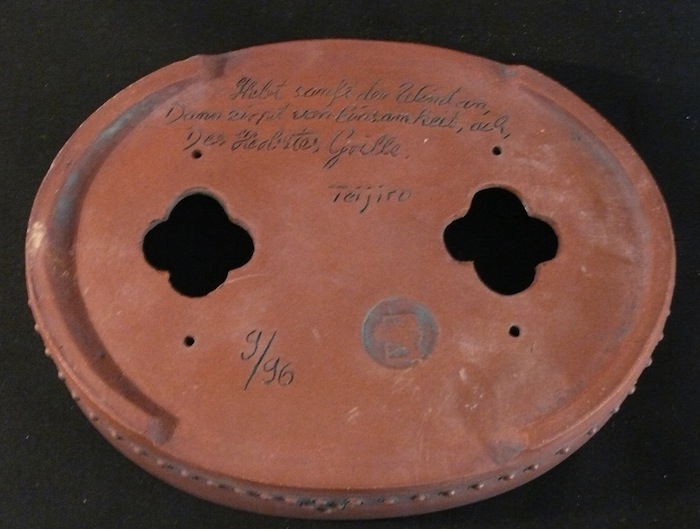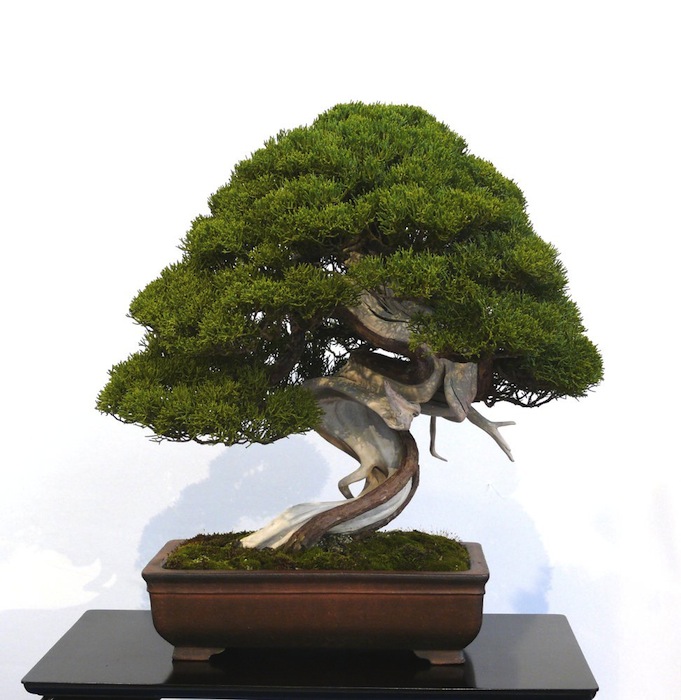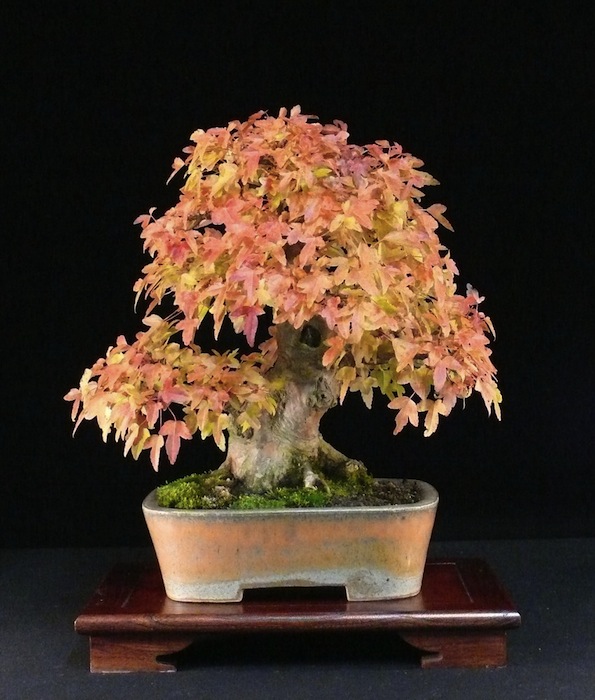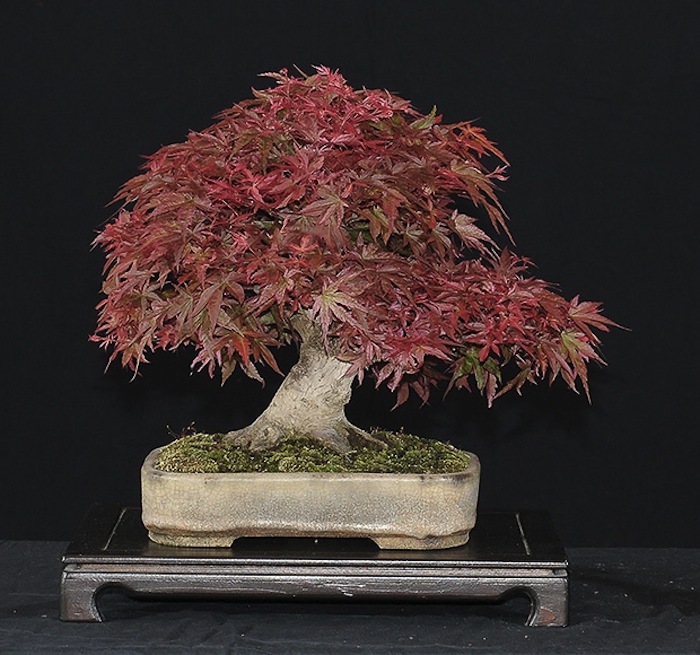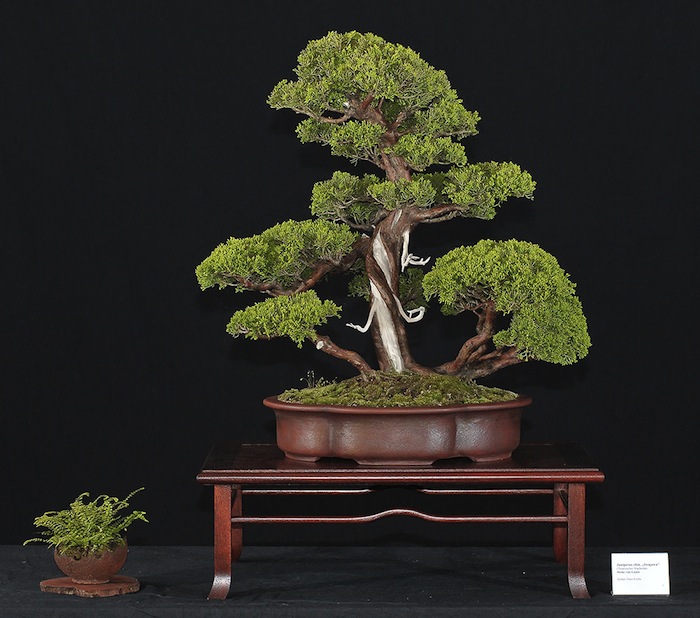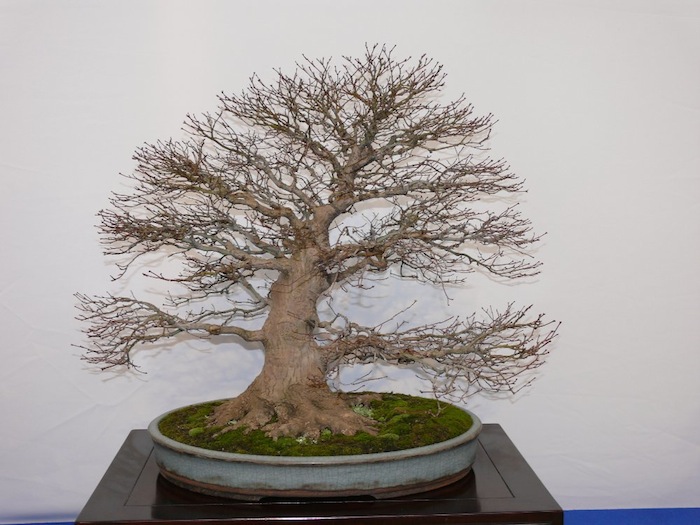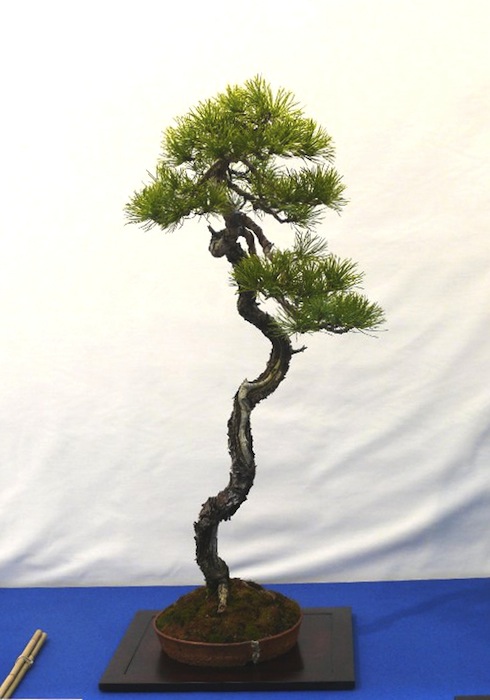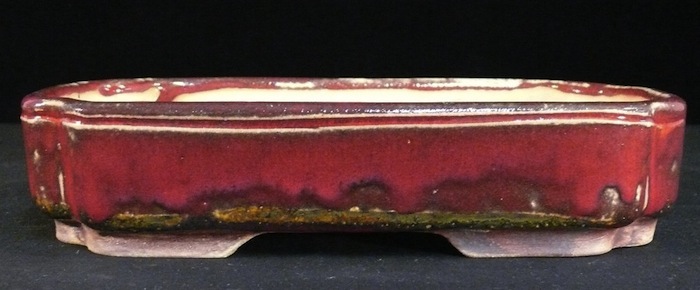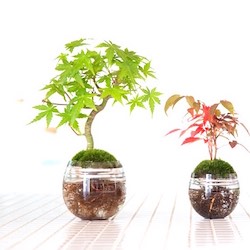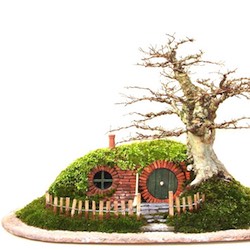The pot is an important component of the Bonsai. Its significance and its part of the impression of the overall picture must not be underestimated.
The pot must fulfill a number of basic practical and aesthetic requirements.
„Millennium“ pot by Peter Krebs.
There are Bonsai pots available in the most different qualities, shapes, colours, sizes, structures, glazed and unglazed ones.
The pot must be frost resistant because in many cases it has to endure cold winters with the bonsai.
A larch bonsai tree in its pot by Erwin Grzesinski in winter.
Drainage holes are essential to avoid lethal root wetness. Additional smaller holes in the bottom are helpful for fastening the tree to the pot with wire.
Bottom of a bonsai pot with large drainage holes and smaller fixation holes.
The cheapest Asian bonsai pots often have ugly shapes and glazes. Not all of them are frost resistant. Some cheap pots are distorted and don't stand safely. Many are uneven inside or have ridges around the drainage holes which hinder proper drainage.
Cheap Asian pot.
From Japan, China and Korea there are middle quality pots which are sufficient for the beginning or for less valuable trees. Those pots are quite plain in shape and colour and frost resistant.
Asian pot of middle quality.
More expensive are „hand made“ pots from the famous Japanese potter village Tokoname. These pots are indeed hand made, but most of them in cast molds. Tokoname pots are beautiful, high quality and available in a great diversity. They are used for valuable exhibition bonsai in Japan as well as in Europe.
Tokoname pot.
In Japan, old and antique bonsai pots are especially appreciated, with a nice patina acquired during many years of use. Antique Chinese pots which are 150 years old and more are extremely expensive and hard to get.
Juniper bonsai at the Noelanders Trophy 2013 in an old bonsai pot with beautiful patina.
Increasingly popular are individually and literally hand made pots which are also produced in the West by talented potters. These pots are often custom-made for a special tree.
Trident maple in a custom-made pot by Horst Heinzlreiter.
These individual art works are accordingly quite expensive and the prices depend on the production effort. The more details, rims, decoration, bands, frames etc. must be shaped the more time and effort it takes and the higher the price.
Very elaborate glazes also influence the price.
Decorated pot by Peter Krebs.
Some bonsai enthusiasts who are fascinated by the interesting subject of pots but don't want to spend so much money on them have even started to make their own pots. A few people achieved very good results! In some cases even a semi-professional business with loyal customers has developed from the initial hobby pottery.
Hobby pottery.
Other bonsai hobbyists develop a deep passion for beautiful bonsai pots. They collect valuable antique pots or the products of famous potters. Those collector's pots are mostly placed in showcases and are hardly used for bonsai.
Bonsai pot shelf.
Instructions for choosing pots
How do you select the right pot for a certain tree? There are a few rules of thumb and guidelines that can help.
Acer palmatum „Seigen“ in a pot by Gordon Duffett (UK).
The tree should be complemented and framed by the pot, but the pot should not outshine the tree.
Conifers traditionally belong in unglazed pots which can sometimes have specially processed surfaces.
Itoigawa juniper in an unglazed pot with a special surface finish by Peter Krebs.
Broadleaved trees are usually planted in glazed pots with unobtrusive colours while flowering and fruitbearing bonsai can have pots with brighter glaze colours. Very gnarled deciduous trees and those with very rough-bark can sometimes also look good in unglazed pots.
Multitrunk Japanese maple in a glazed pot by Peter Krebs.
The depth of the pot should correspond with the thickness of the trunk base.
Length of the pot: about 2/3 of the tree's height (red), depth of the pot: approximately equal to the diameter of the trunk base (blue). Corean hornbeam in a pot by Erwin Grzesinski.
Exceptions are forests and group plantings which are mostly planted in very shallow pots. Cascades and semi-cascades are also an exception as they need deep, heavy pots as a physical and visual counterweight.
Pinus sylvestris cascade by David Benavente in a Tokoname pot.
The pot ought to reflect the shapes of the tree. A lovely deciduous tree, like an informal upright Japanes Maple with a softly curved trunk, always looks good in an oval pot, typically with a pale green, blue or beige glaze.
Japanese maple by Udo Fischer in a pot by Gordon Duffett.
A masculine, formally shaped conifer with a massive trunk is in most cases perfectly supported by a rectangular, dark, unglazed pot.
Shohin Japanese white pine by Marc and Ritta Cooper in a dark rectangularTokoname pot.
Informal upright bonsai trees are most often planted in oval pots and formal upright trees in rectangular pots.
Formal upright larch in a formal rectangular pot at the Noelanders Trophy 2013.
The bunjin style needs a round pot which in most cases is quite shallow and small and can be irregularly shaped, looking primitive (called nanban pots). Some valuable hand made nanban pot can appear so imperfect that you could think the potter just failed to make a good one. But this is not true as those pots are carefully shaped.
They support the beauty of modesty, irregularity and imperfection which can be achieved to a great extent in a bunjin bonsai.
Bunjin pine in a small round pot.
Cascade pots are more or less deep, depending on the length and visual or physical weight of the cascading tree. Their outline is in most cases square, hexagonal, octagonal or round.
Shohin cascading pine in a round Tokoname cascade drum pot.
Broom styles in most cases are planted in shallow oval or rectangular pots.
Japanese maple in an informal broom style by Walter Pall in an oval large bonsai pot.
Windswept bonsai look very good in shallow oval, rectangular or irregular shaped pots or on stone or ceramic slabs.
Forests, group plantings and raft styles are planted in shallow oval or rectangular pots ore on stone slabs or ceramic slabs.
Spruce forest on a stone slab.
For old Yamadori from the mountains, which often have a breathtaking bark and very individual shapes, some European potters have created lovely rough, fissured surface structures and very unusual pot shapes because those trees are often impossible to classify.
Yamadori pine in an individual pot by Erik Krizovensky.
If you observe the above rules as good as possible in the beginning you won't make very bad mistakes.
To be able to confidently choose suitable pots needs a sure instinct and a lot of experience.
It helps to look at many illustrated books of important exhibitions (the Kokufu show in Japan for example) and pay attention to the tree – pot combinations. Reflecting on the intentions of the bonsai artist who chose the pot and what it symbolizes in combination with the tree will get you many useful insights.
Bonsai pot book by Kunio Kobayashi with lots of lovely examples.
If you have become quite secure in pot choice by following the traditional rules and looking at manifold illustrative material, nothing must keep you from trying more unusual and extraordinary combinations.
Unusual red glazed pot by Peter Krebs.
Written by: Heike van Gunst. "Heike van Gunst (from Hamburg, Germany) has been growing Bonsai for more than 30 years. She has gained manifold skills in training and caring for diverse species and has developed a passion for Bonsai pots and Bonsai display. Writing and translating Bonsai articles and Bonsai book translations are her special subject.".



